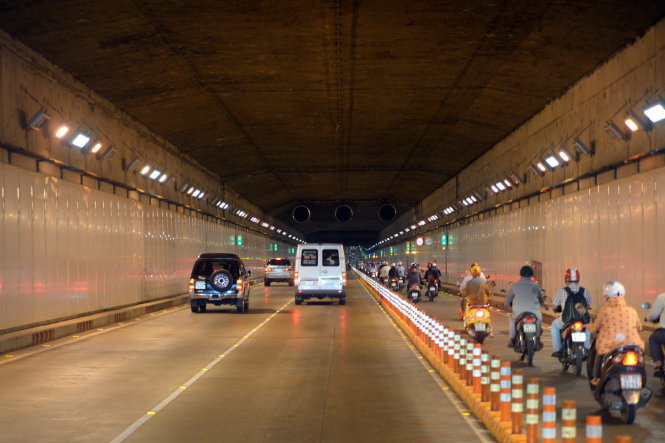The ‘nerve-center’ of the Saigon River Tunnel, the largest under a river across Southeast Asia, works around the clock to ensure the seamless operation of the passageway and drivers’ perfect safety.
The Saigon River Tunnel, also known as Thu Thiem Tunnel which links Districts 1 and 2 in Ho Chi Minh City, was put into operation five years ago.
The 256-kilometer Saigon River snakes through Ho Chi Minh City and some of its neighboring towns.
Drivers may find the relentless buzz emitted by huge reactive fans along the Saigon River Tunnel quite annoying.
Traffic inside the passageway flows in two directions, each lane has six fans, spanning 1.25 meters in diameter and 3.25 meters in length, according to Doan Van Tan, deputy director of the Saigon River Tunnel Management Center.
Two towering equipment buildings perch at each end, connecting the two sections of the shaft.
Tan guided Tuoi Tre (Youth) newspaper reporters into the building at the District 2 end.
“The fans are designed for better ventilation, which keeps drivers from choking when moving through the tunnel,” he explained. Inside the window-less structure, staff can only hear each other when the fans are turned off.
The cylindrically shaped fans, which measure 3.75 meters in diameter and reach a staggering height of 18 meters, are designed to extract vehicle emissions from the tunnel and into the two towers’ processing system.
The ‘creepy’ room in the first basement of one of the apparatus’ buildings is an intriguing place.
The room has four soot-smeared walls and houses gigantic dust filtering nets.
Tan, the deputy director of the Saigon River Tunnel Management Center, said no one dares step in the room while the fans are being operated as they exert a tornado-like suction.
“The air is purified thanks to the fans before being released back into the environment. Using another processing system, the collected dust becomes solid black matter,” he explained.

Staff monitor everything that happens inside the tunnel. Photo: Tuoi Tre
The amount of collected dust depends on the volume of traffic passing through the tunnel.
Tan added that his team normally gathers several sacks of precipitated dust each month.
In the event of a fire, the huge ventilation system will automatically isolate all the fans and stop them from spreading the fire.
These reactive fans can also reverse directions to push fumes into the area nearest to the tunnel end.
Curiously, this apparatus building houses two ‘VIP’ rooms which stay air-conditioned around the clock so as to lengthen the life span of electrical appliances and prevent incidents of fire for example.
The rooms also supply low-voltage and mid-voltage electricity for the entire tunnel.
“For keynote structures like the Saigon River Tunnel, the power system is like that of the arteries inside a human body. To keep the arteries moving seamlessly, power is supplied from two separate sources: two intermediary stations in District 1 and District 2,” Tan noted.
In case of a power outage, the system operators can turn to the other, or to the generator if both fail.
A camera system is also conducive to the smooth, faultless operation of the tunnel by capturing images of all that is going on inside the tube.
Each shift has one supervisor and eight staffers who fasten their eyes on the monitors and keep a close watch on traffic moving on hundreds of streets throughout Ho Chi Minh City.
According to Phan Quoc Nhat, in charge of traffic safety surveillance and communication inside the tunnel, during each eight-hour shift, staffers are supposed to pay undivided attention to their work and promptly notify their supervisor of emergencies, such as vehicles parking inside the tunnel.

Emissions condense into solid black masses. Photo: Tuoi Tre
Nguyen Xuan Thanh, responsible for ventilation, drainage and fire prevention, said the tunnel has sensors which can gauge the speed of winds, waste emissions and visibility inside the tunnel with great precision.
The maintenance team works on the tunnel from 10:00 pm to 5:00 am every night.
The lighting system, including intensive, daytime and emergency illumination, operates around the clock to ensure drivers’ safety.
The Saigon River Tunnel is designed with a vertical gradient of four percent, and has ditches at both ends to facilitate drainage, particularly during flooding and high tides, one of the city’s chronic plagues.
|
The Saigon River Tunnel, beneath the Saigon River, was open to traffic in November 2011 after seven years of construction. The tube, Southeast Asia’s largest tunnel crossing under a river, has six lanes and measures 1,490 meters in length, including a submerged section spanning 370.8 meters. The tunnel consumes an average of 3.79 million kWh each year, or 10,196 kWh on a daily basis. Its ventilation and filtering systems purify 5.25 billion cubic meters of vehicle emissions on average each year, or 14.3 million cubic meters per day. |
Like us on Facebook or follow us on Twitter to get the latest news about Vietnam!





















































